Business Strategy Analysis: Tesco PLC and Sainsbury PLC Report
VerifiedAdded on 2020/03/04
|7
|1321
|281
Report
AI Summary
This report provides a detailed analysis of the business strategies employed by Tesco PLC and Sainsbury PLC, two prominent players in the UK grocery and retail market. It begins with an overview of Tesco, its market position, and its commitment to customer value through innovative product offerings and marketing strategies like the Clubcard rewards program. The report then delves into a SWOT analysis of Tesco, examining its strengths in distribution and brand recognition, weaknesses in pricing strategy and increasing debt, opportunities for growth through diversification, and threats from economic instability and competition. Following this, the report shifts its focus to Sainsbury, highlighting its market share, strategic focus on price-responsive consumers, and commitment to sustainable farming. A SWOT analysis of Sainsbury reveals its strengths in diversified operations and CSR initiatives, weaknesses in advertising and foreign market presence, opportunities in customer loyalty programs and collaborations, and threats from competition, technological advancements, and cyber security. The report concludes by offering a comparative perspective on the strategies of both companies, providing valuable insights into their competitive dynamics and market positioning.
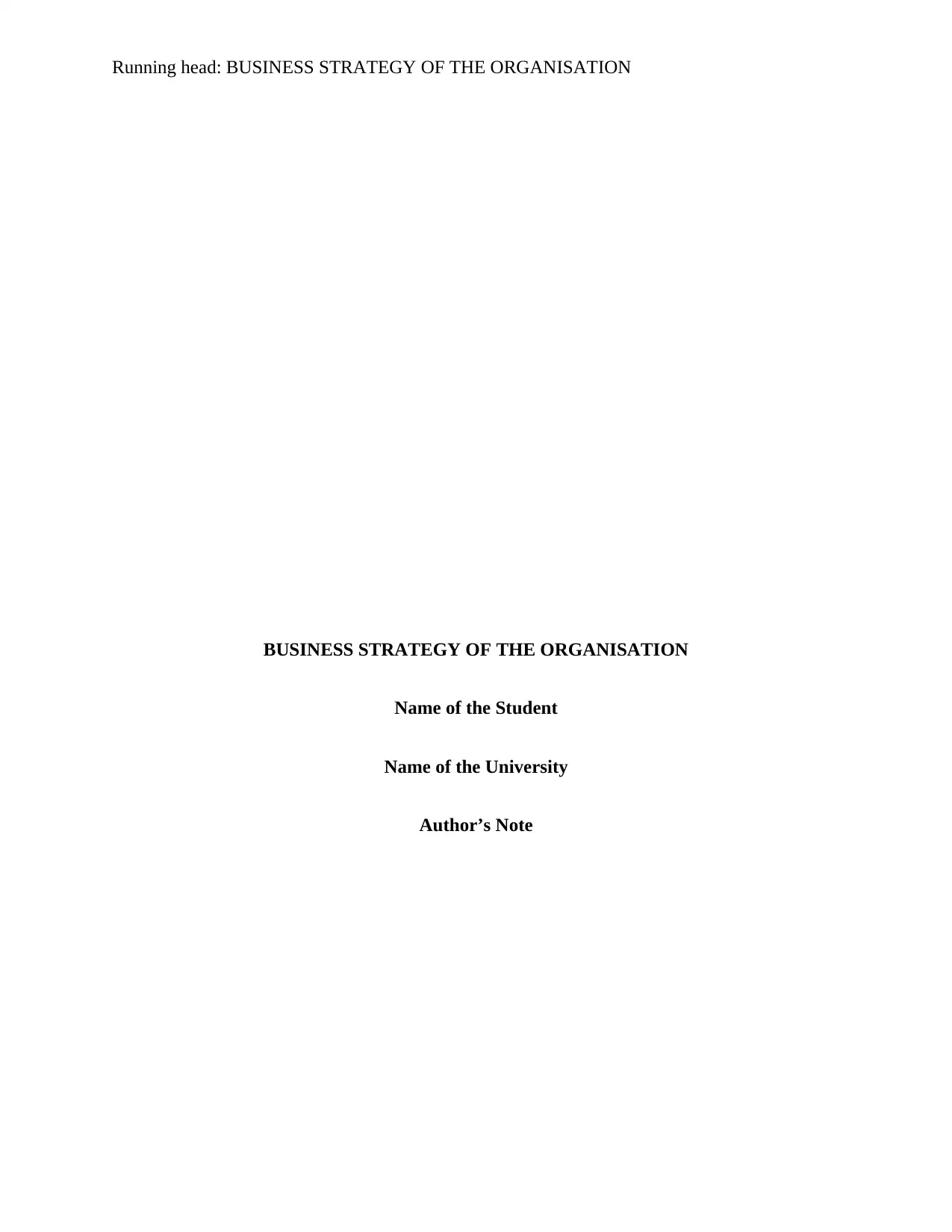
Running head: BUSINESS STRATEGY OF THE ORGANISATION
BUSINESS STRATEGY OF THE ORGANISATION
Name of the Student
Name of the University
Author’s Note
BUSINESS STRATEGY OF THE ORGANISATION
Name of the Student
Name of the University
Author’s Note
Paraphrase This Document
Need a fresh take? Get an instant paraphrase of this document with our AI Paraphraser
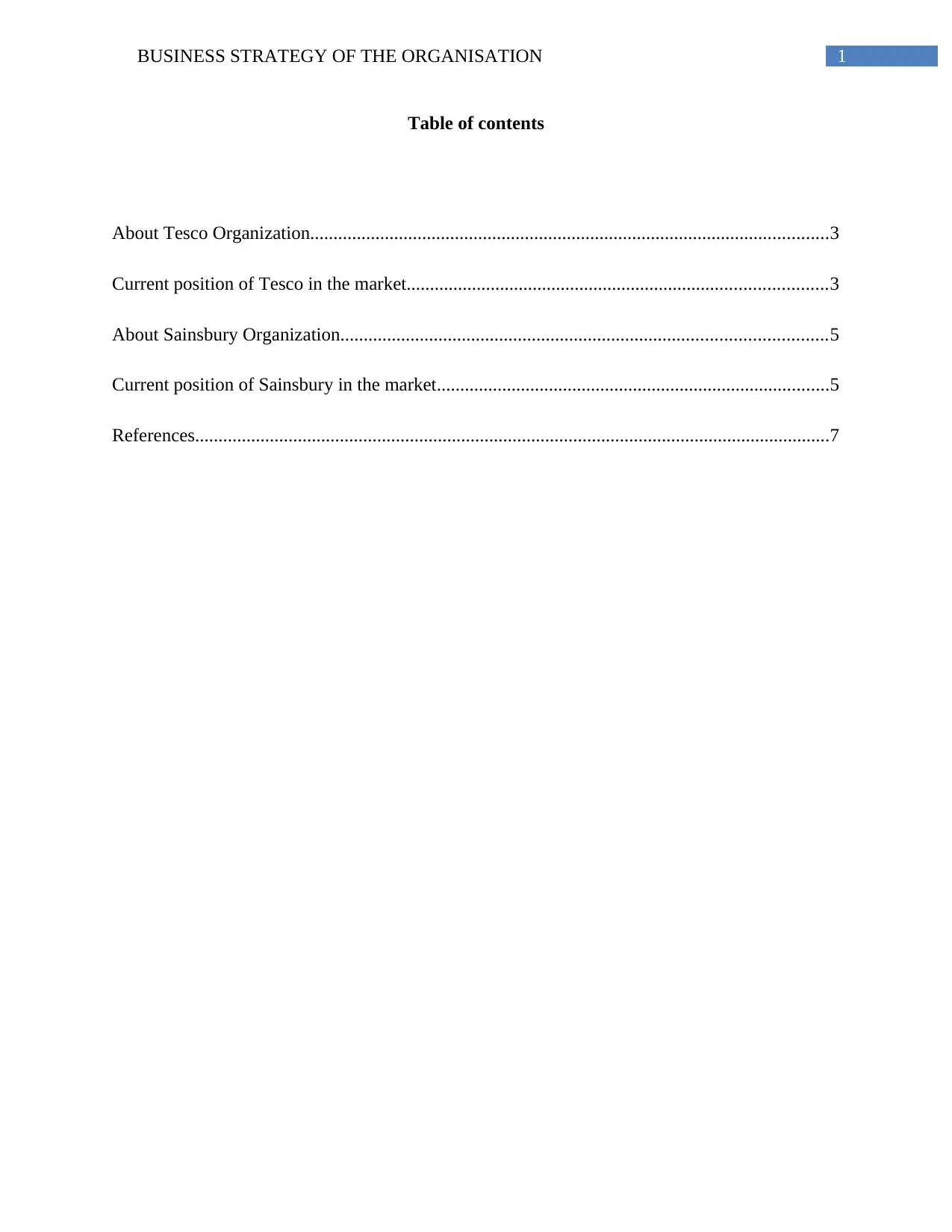
1BUSINESS STRATEGY OF THE ORGANISATION
Table of contents
About Tesco Organization...............................................................................................................3
Current position of Tesco in the market..........................................................................................3
About Sainsbury Organization........................................................................................................5
Current position of Sainsbury in the market....................................................................................5
References........................................................................................................................................7
Table of contents
About Tesco Organization...............................................................................................................3
Current position of Tesco in the market..........................................................................................3
About Sainsbury Organization........................................................................................................5
Current position of Sainsbury in the market....................................................................................5
References........................................................................................................................................7
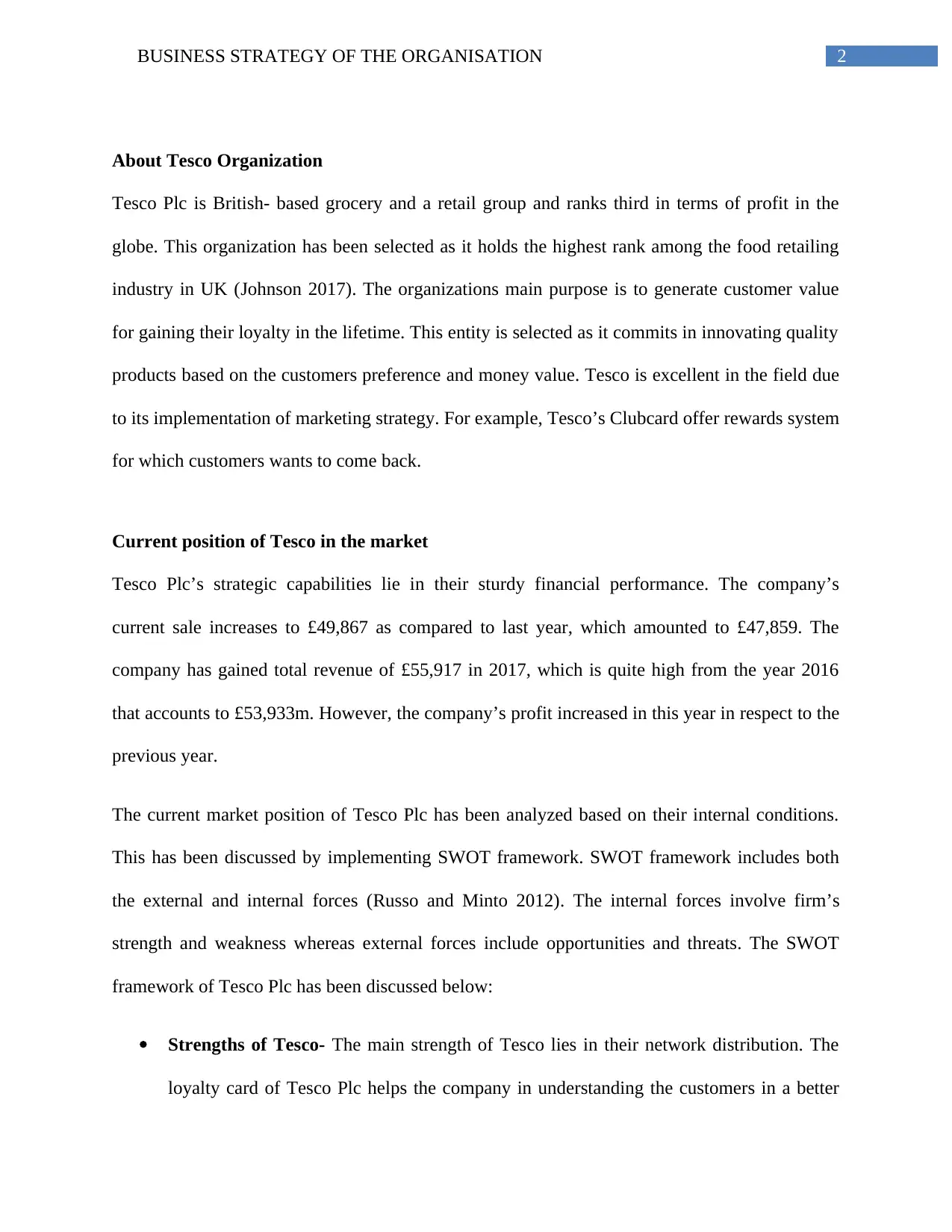
2BUSINESS STRATEGY OF THE ORGANISATION
About Tesco Organization
Tesco Plc is British- based grocery and a retail group and ranks third in terms of profit in the
globe. This organization has been selected as it holds the highest rank among the food retailing
industry in UK (Johnson 2017). The organizations main purpose is to generate customer value
for gaining their loyalty in the lifetime. This entity is selected as it commits in innovating quality
products based on the customers preference and money value. Tesco is excellent in the field due
to its implementation of marketing strategy. For example, Tesco’s Clubcard offer rewards system
for which customers wants to come back.
Current position of Tesco in the market
Tesco Plc’s strategic capabilities lie in their sturdy financial performance. The company’s
current sale increases to £49,867 as compared to last year, which amounted to £47,859. The
company has gained total revenue of £55,917 in 2017, which is quite high from the year 2016
that accounts to £53,933m. However, the company’s profit increased in this year in respect to the
previous year.
The current market position of Tesco Plc has been analyzed based on their internal conditions.
This has been discussed by implementing SWOT framework. SWOT framework includes both
the external and internal forces (Russo and Minto 2012). The internal forces involve firm’s
strength and weakness whereas external forces include opportunities and threats. The SWOT
framework of Tesco Plc has been discussed below:
Strengths of Tesco- The main strength of Tesco lies in their network distribution. The
loyalty card of Tesco Plc helps the company in understanding the customers in a better
About Tesco Organization
Tesco Plc is British- based grocery and a retail group and ranks third in terms of profit in the
globe. This organization has been selected as it holds the highest rank among the food retailing
industry in UK (Johnson 2017). The organizations main purpose is to generate customer value
for gaining their loyalty in the lifetime. This entity is selected as it commits in innovating quality
products based on the customers preference and money value. Tesco is excellent in the field due
to its implementation of marketing strategy. For example, Tesco’s Clubcard offer rewards system
for which customers wants to come back.
Current position of Tesco in the market
Tesco Plc’s strategic capabilities lie in their sturdy financial performance. The company’s
current sale increases to £49,867 as compared to last year, which amounted to £47,859. The
company has gained total revenue of £55,917 in 2017, which is quite high from the year 2016
that accounts to £53,933m. However, the company’s profit increased in this year in respect to the
previous year.
The current market position of Tesco Plc has been analyzed based on their internal conditions.
This has been discussed by implementing SWOT framework. SWOT framework includes both
the external and internal forces (Russo and Minto 2012). The internal forces involve firm’s
strength and weakness whereas external forces include opportunities and threats. The SWOT
framework of Tesco Plc has been discussed below:
Strengths of Tesco- The main strength of Tesco lies in their network distribution. The
loyalty card of Tesco Plc helps the company in understanding the customers in a better
⊘ This is a preview!⊘
Do you want full access?
Subscribe today to unlock all pages.

Trusted by 1+ million students worldwide
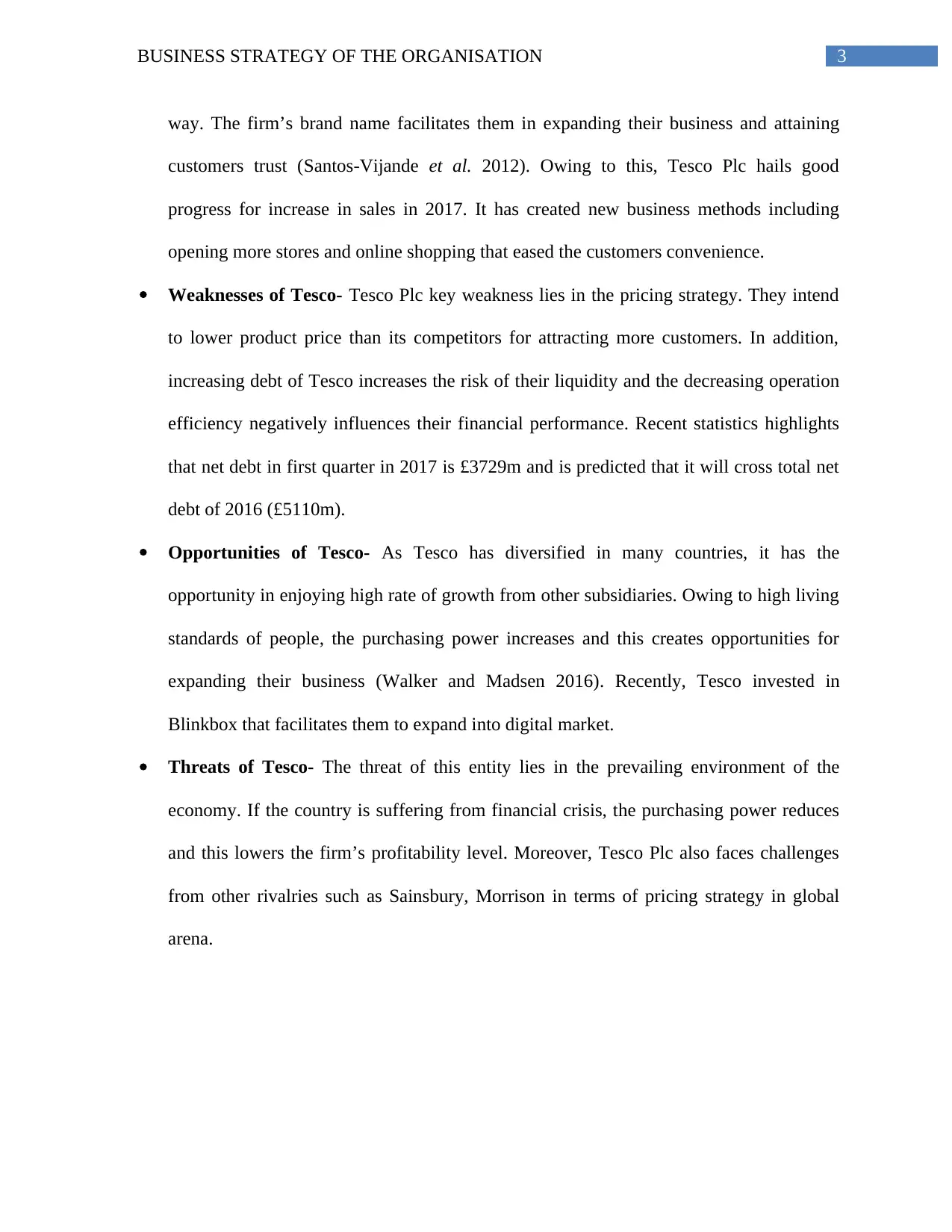
3BUSINESS STRATEGY OF THE ORGANISATION
way. The firm’s brand name facilitates them in expanding their business and attaining
customers trust (Santos-Vijande et al. 2012). Owing to this, Tesco Plc hails good
progress for increase in sales in 2017. It has created new business methods including
opening more stores and online shopping that eased the customers convenience.
Weaknesses of Tesco- Tesco Plc key weakness lies in the pricing strategy. They intend
to lower product price than its competitors for attracting more customers. In addition,
increasing debt of Tesco increases the risk of their liquidity and the decreasing operation
efficiency negatively influences their financial performance. Recent statistics highlights
that net debt in first quarter in 2017 is £3729m and is predicted that it will cross total net
debt of 2016 (£5110m).
Opportunities of Tesco- As Tesco has diversified in many countries, it has the
opportunity in enjoying high rate of growth from other subsidiaries. Owing to high living
standards of people, the purchasing power increases and this creates opportunities for
expanding their business (Walker and Madsen 2016). Recently, Tesco invested in
Blinkbox that facilitates them to expand into digital market.
Threats of Tesco- The threat of this entity lies in the prevailing environment of the
economy. If the country is suffering from financial crisis, the purchasing power reduces
and this lowers the firm’s profitability level. Moreover, Tesco Plc also faces challenges
from other rivalries such as Sainsbury, Morrison in terms of pricing strategy in global
arena.
way. The firm’s brand name facilitates them in expanding their business and attaining
customers trust (Santos-Vijande et al. 2012). Owing to this, Tesco Plc hails good
progress for increase in sales in 2017. It has created new business methods including
opening more stores and online shopping that eased the customers convenience.
Weaknesses of Tesco- Tesco Plc key weakness lies in the pricing strategy. They intend
to lower product price than its competitors for attracting more customers. In addition,
increasing debt of Tesco increases the risk of their liquidity and the decreasing operation
efficiency negatively influences their financial performance. Recent statistics highlights
that net debt in first quarter in 2017 is £3729m and is predicted that it will cross total net
debt of 2016 (£5110m).
Opportunities of Tesco- As Tesco has diversified in many countries, it has the
opportunity in enjoying high rate of growth from other subsidiaries. Owing to high living
standards of people, the purchasing power increases and this creates opportunities for
expanding their business (Walker and Madsen 2016). Recently, Tesco invested in
Blinkbox that facilitates them to expand into digital market.
Threats of Tesco- The threat of this entity lies in the prevailing environment of the
economy. If the country is suffering from financial crisis, the purchasing power reduces
and this lowers the firm’s profitability level. Moreover, Tesco Plc also faces challenges
from other rivalries such as Sainsbury, Morrison in terms of pricing strategy in global
arena.
Paraphrase This Document
Need a fresh take? Get an instant paraphrase of this document with our AI Paraphraser
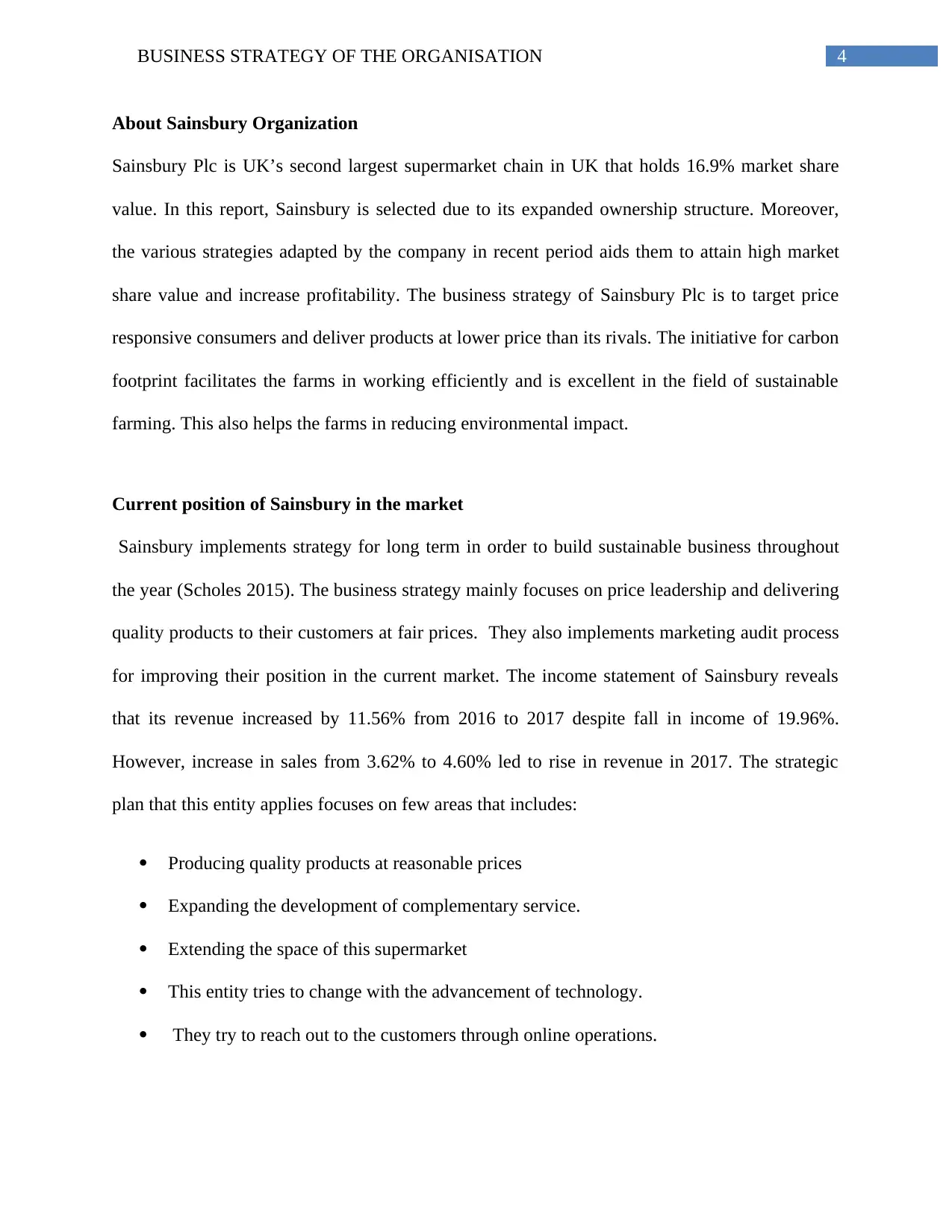
4BUSINESS STRATEGY OF THE ORGANISATION
About Sainsbury Organization
Sainsbury Plc is UK’s second largest supermarket chain in UK that holds 16.9% market share
value. In this report, Sainsbury is selected due to its expanded ownership structure. Moreover,
the various strategies adapted by the company in recent period aids them to attain high market
share value and increase profitability. The business strategy of Sainsbury Plc is to target price
responsive consumers and deliver products at lower price than its rivals. The initiative for carbon
footprint facilitates the farms in working efficiently and is excellent in the field of sustainable
farming. This also helps the farms in reducing environmental impact.
Current position of Sainsbury in the market
Sainsbury implements strategy for long term in order to build sustainable business throughout
the year (Scholes 2015). The business strategy mainly focuses on price leadership and delivering
quality products to their customers at fair prices. They also implements marketing audit process
for improving their position in the current market. The income statement of Sainsbury reveals
that its revenue increased by 11.56% from 2016 to 2017 despite fall in income of 19.96%.
However, increase in sales from 3.62% to 4.60% led to rise in revenue in 2017. The strategic
plan that this entity applies focuses on few areas that includes:
Producing quality products at reasonable prices
Expanding the development of complementary service.
Extending the space of this supermarket
This entity tries to change with the advancement of technology.
They try to reach out to the customers through online operations.
About Sainsbury Organization
Sainsbury Plc is UK’s second largest supermarket chain in UK that holds 16.9% market share
value. In this report, Sainsbury is selected due to its expanded ownership structure. Moreover,
the various strategies adapted by the company in recent period aids them to attain high market
share value and increase profitability. The business strategy of Sainsbury Plc is to target price
responsive consumers and deliver products at lower price than its rivals. The initiative for carbon
footprint facilitates the farms in working efficiently and is excellent in the field of sustainable
farming. This also helps the farms in reducing environmental impact.
Current position of Sainsbury in the market
Sainsbury implements strategy for long term in order to build sustainable business throughout
the year (Scholes 2015). The business strategy mainly focuses on price leadership and delivering
quality products to their customers at fair prices. They also implements marketing audit process
for improving their position in the current market. The income statement of Sainsbury reveals
that its revenue increased by 11.56% from 2016 to 2017 despite fall in income of 19.96%.
However, increase in sales from 3.62% to 4.60% led to rise in revenue in 2017. The strategic
plan that this entity applies focuses on few areas that includes:
Producing quality products at reasonable prices
Expanding the development of complementary service.
Extending the space of this supermarket
This entity tries to change with the advancement of technology.
They try to reach out to the customers through online operations.
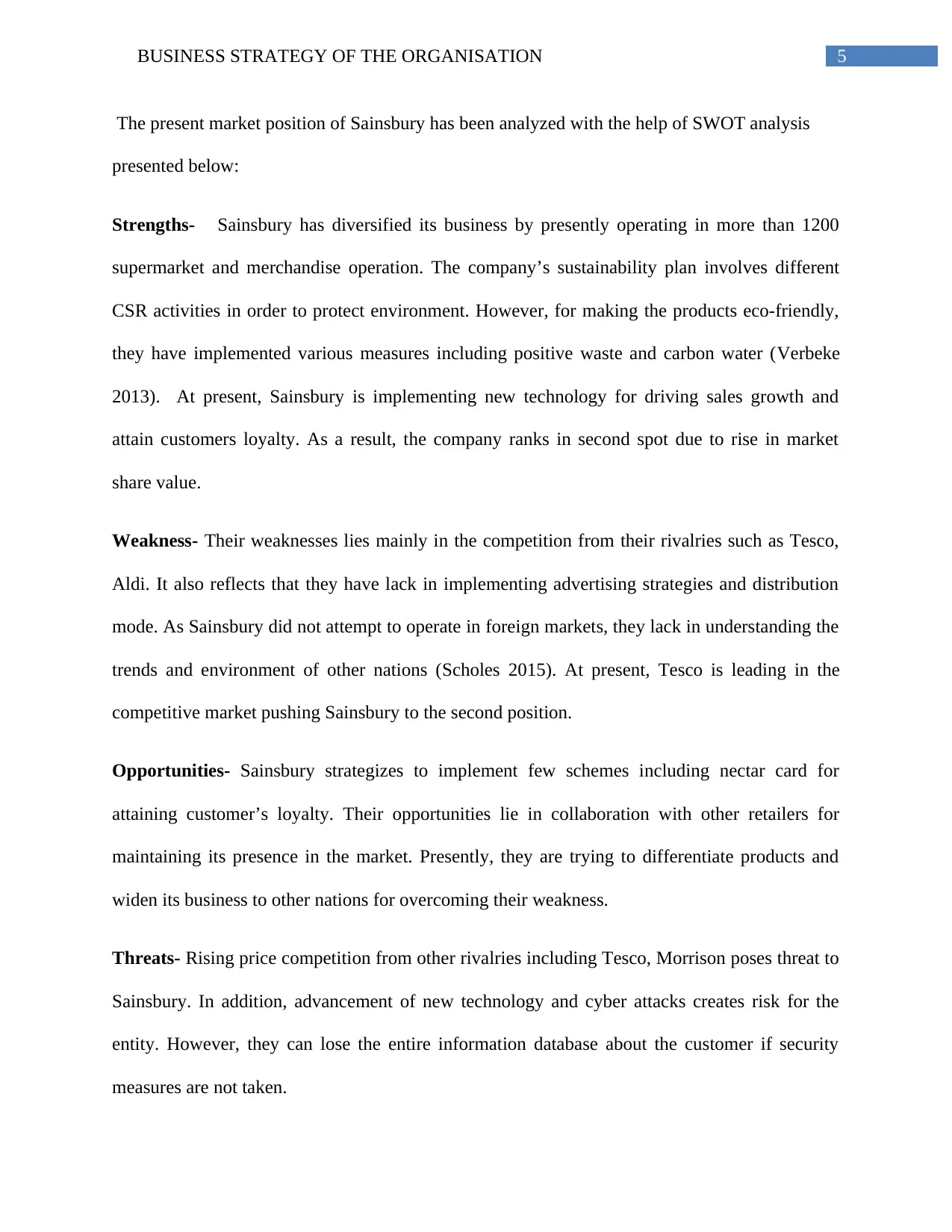
5BUSINESS STRATEGY OF THE ORGANISATION
The present market position of Sainsbury has been analyzed with the help of SWOT analysis
presented below:
Strengths- Sainsbury has diversified its business by presently operating in more than 1200
supermarket and merchandise operation. The company’s sustainability plan involves different
CSR activities in order to protect environment. However, for making the products eco-friendly,
they have implemented various measures including positive waste and carbon water (Verbeke
2013). At present, Sainsbury is implementing new technology for driving sales growth and
attain customers loyalty. As a result, the company ranks in second spot due to rise in market
share value.
Weakness- Their weaknesses lies mainly in the competition from their rivalries such as Tesco,
Aldi. It also reflects that they have lack in implementing advertising strategies and distribution
mode. As Sainsbury did not attempt to operate in foreign markets, they lack in understanding the
trends and environment of other nations (Scholes 2015). At present, Tesco is leading in the
competitive market pushing Sainsbury to the second position.
Opportunities- Sainsbury strategizes to implement few schemes including nectar card for
attaining customer’s loyalty. Their opportunities lie in collaboration with other retailers for
maintaining its presence in the market. Presently, they are trying to differentiate products and
widen its business to other nations for overcoming their weakness.
Threats- Rising price competition from other rivalries including Tesco, Morrison poses threat to
Sainsbury. In addition, advancement of new technology and cyber attacks creates risk for the
entity. However, they can lose the entire information database about the customer if security
measures are not taken.
The present market position of Sainsbury has been analyzed with the help of SWOT analysis
presented below:
Strengths- Sainsbury has diversified its business by presently operating in more than 1200
supermarket and merchandise operation. The company’s sustainability plan involves different
CSR activities in order to protect environment. However, for making the products eco-friendly,
they have implemented various measures including positive waste and carbon water (Verbeke
2013). At present, Sainsbury is implementing new technology for driving sales growth and
attain customers loyalty. As a result, the company ranks in second spot due to rise in market
share value.
Weakness- Their weaknesses lies mainly in the competition from their rivalries such as Tesco,
Aldi. It also reflects that they have lack in implementing advertising strategies and distribution
mode. As Sainsbury did not attempt to operate in foreign markets, they lack in understanding the
trends and environment of other nations (Scholes 2015). At present, Tesco is leading in the
competitive market pushing Sainsbury to the second position.
Opportunities- Sainsbury strategizes to implement few schemes including nectar card for
attaining customer’s loyalty. Their opportunities lie in collaboration with other retailers for
maintaining its presence in the market. Presently, they are trying to differentiate products and
widen its business to other nations for overcoming their weakness.
Threats- Rising price competition from other rivalries including Tesco, Morrison poses threat to
Sainsbury. In addition, advancement of new technology and cyber attacks creates risk for the
entity. However, they can lose the entire information database about the customer if security
measures are not taken.
⊘ This is a preview!⊘
Do you want full access?
Subscribe today to unlock all pages.

Trusted by 1+ million students worldwide
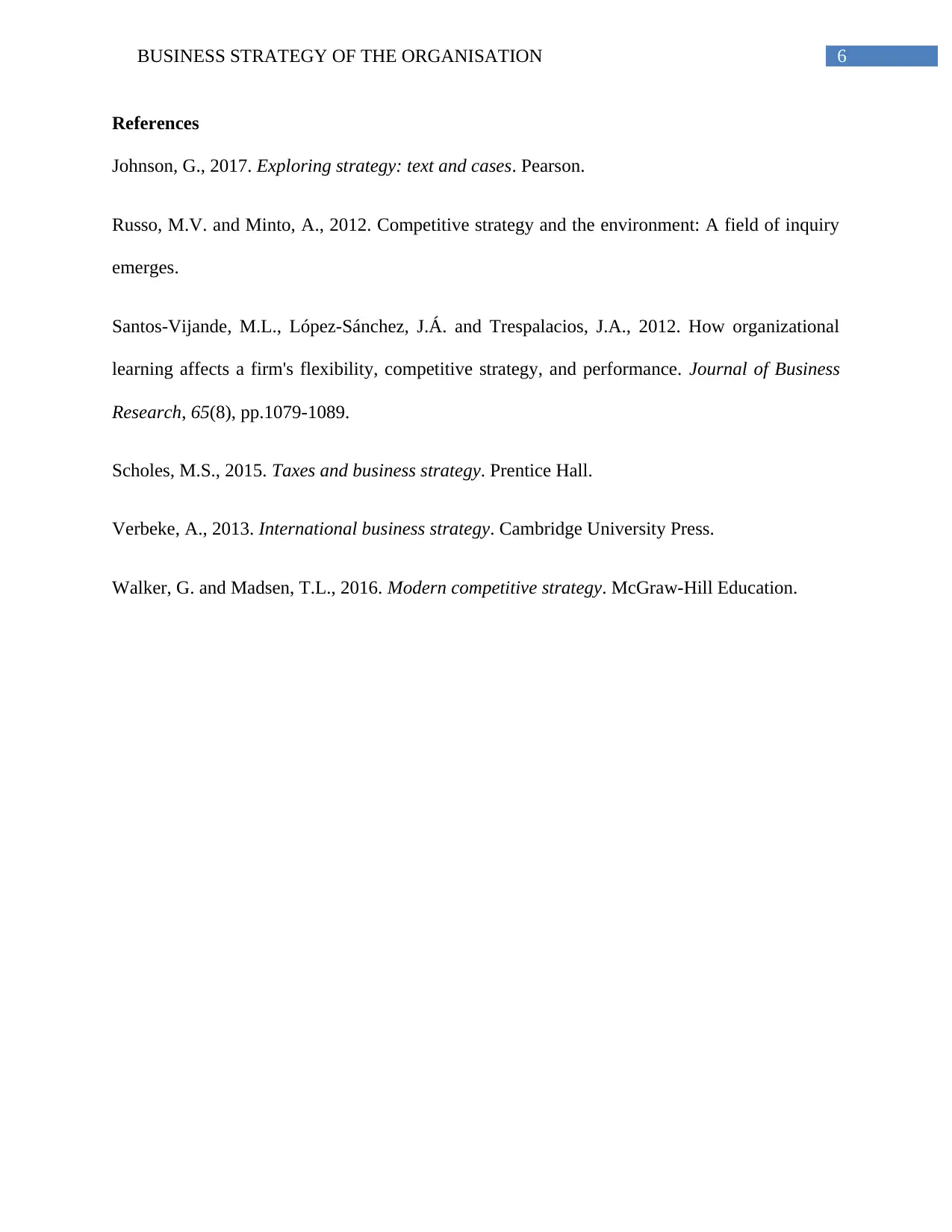
6BUSINESS STRATEGY OF THE ORGANISATION
References
Johnson, G., 2017. Exploring strategy: text and cases. Pearson.
Russo, M.V. and Minto, A., 2012. Competitive strategy and the environment: A field of inquiry
emerges.
Santos-Vijande, M.L., López-Sánchez, J.Á. and Trespalacios, J.A., 2012. How organizational
learning affects a firm's flexibility, competitive strategy, and performance. Journal of Business
Research, 65(8), pp.1079-1089.
Scholes, M.S., 2015. Taxes and business strategy. Prentice Hall.
Verbeke, A., 2013. International business strategy. Cambridge University Press.
Walker, G. and Madsen, T.L., 2016. Modern competitive strategy. McGraw-Hill Education.
References
Johnson, G., 2017. Exploring strategy: text and cases. Pearson.
Russo, M.V. and Minto, A., 2012. Competitive strategy and the environment: A field of inquiry
emerges.
Santos-Vijande, M.L., López-Sánchez, J.Á. and Trespalacios, J.A., 2012. How organizational
learning affects a firm's flexibility, competitive strategy, and performance. Journal of Business
Research, 65(8), pp.1079-1089.
Scholes, M.S., 2015. Taxes and business strategy. Prentice Hall.
Verbeke, A., 2013. International business strategy. Cambridge University Press.
Walker, G. and Madsen, T.L., 2016. Modern competitive strategy. McGraw-Hill Education.
1 out of 7
Related Documents
Your All-in-One AI-Powered Toolkit for Academic Success.
+13062052269
info@desklib.com
Available 24*7 on WhatsApp / Email
![[object Object]](/_next/static/media/star-bottom.7253800d.svg)
Unlock your academic potential
Copyright © 2020–2025 A2Z Services. All Rights Reserved. Developed and managed by ZUCOL.





